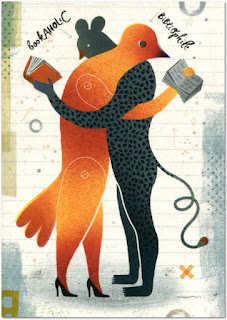Bookplates for Libraries

Going through my Holman Archives of donated ephemera recently, I came across a set of promotional pieces for a 1968 Roger Beacham (Bill Holman's imprint) publication: Bookplates for Libraries, by Edward Hampton Shickell.
I recalled reading a post on the Library History Buff blog about the book and thought these items would provide a tie-in from the printed ephemera angle. Included here in this "prospectus package" are an announcement, a brochure, and a piece featuring William R. Holman's Introduction to the book. Each has a distinct job to do for promoting the book, but collectively they function as a prospectus.
First up is the announcement of the book and a pre-publication offer. The oblong design opens to nearly twenty inches in length, features a brief description of the book and author, and examples of four bookplates accompanied by this statement about the book: A reference work which answers every librarian's need for appropriate and well designed bookplates.


The next piece in this trio is a 10 by 14-inch sheet folded to effect a four-page sampling of bookplate designs, accompanied by William R. Holman's Introduction for the book, titled An approach to contemporary library bookplates. I like the answer to his opening question, Why bookplates for libraries? And I think his answer is applicable to personal as well as public libraries:
There is something so eternal and everlasting about the bookplates--they not only lend dignity and grace to a library's collection but they attest to man's belief in, and love of, the printed word.



The last piece of advertising for Bookplates for Libraries is a tri-fold brochure with the front cover about half the size of the other pages in width, with an aesthetically pleasing ragged edge. Equal amounts of space are dedicated to Donald Dickinson's review and more examples of the bookplates that represent the content of the book.



Each piece of ephemera comprising this prospectus combo has a particular function in promoting the book and their coordinated design sets the proper tone for one of the core themes of the book, which Dickinson echoed in his review:
The volume itself is a convincing argument of the thoughtful combination of type, ink and paper.And that's what you get with these three examples of promotional ephemera--the thoughtful combination of type, ink and paper.
Read more about book prospectuses at the always excellent The Private Library blog, where L.D. Mitchell has written The Prospectus and the Private Library



Chuck - Do you know how I can contact the owner of this blog? http://billheads.blogspot.com/
ReplyDeleteLet me know if you do. I'd like to link to him, but Can't find any contact information on the blog itself.
Dave, I can't find a name or contact for her. Her profile here doesn't offer any help. If you haven't done so already, I would try leaving a comments on one of her blogs to contact you. Sorry I couldn't be of more help.
ReplyDeleteThanks, Chuck. I've left two comments since Friday AM on her billheads blog, but she has not responded nor approved the comments. I'll try the other as well.
ReplyDelete